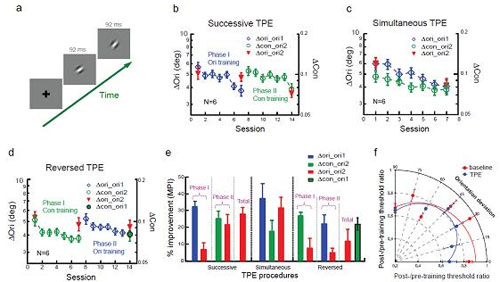知觉学习(perceptual learning)是指训练或经验引起的感知觉能力的改变。近年来,知觉学习作为研究大脑神经可塑性的重要手段越来越受到科学家的重视。传统的知觉学习研究发现,知觉学习有两个基本特征:网膜位置特异性与特征特异性, 即知觉学习不能迁移到未训练的网膜位置和特征。各种知觉学习理论也因此需要解释这些特异性产生的机制。
北京师范大学认知神经科学与学习国家重点实验室视觉心理物理实验室以张俊云博士为第一作者, 余聪教授为通讯作者于2010年9月在Journal of Neuroscience发表了题为 "Rule-based learning explains visual perceptual learning and its specificity and transfer”的论文。该论文的合作者包括加州大学伯克利分校Dennis Levi教授和Stanley Klein教授。博士生张功亮作为第二作者参与了这一研究。
视觉心理物理实验室此前曾证明,知觉学习可以在不同的网膜位置迁移(Xiao et al., Current Biology, 2008)。新发表的研究运用了一个Training + Exposure (TPE)的创新性实验范式,证明知觉学习也可以在不同的刺激朝向之间进行完全迁移(附图)。这些研究结果质疑了普遍接受的知觉学习具有网膜位置特异性与特征特异性的认识,以及基于这些特异性的各种知觉学习理论。研究者因此提出了一个新的基于规则的知觉学习理论(A rule-based theory of perceptual learning),认为知觉学习是位于高级脑区的决策单元通过训练来学会对感觉输入进行权重调整的规则的过程;但因为在知觉训练中注意过于指向所训练的位置和特征而抑制了代表非训练位置和特征的感觉输入,已学会的规则并不能自动应用于这些被抑制的感觉输入上,导致知觉学习的特异性;通过激活这些被抑制的感觉输入以在决策单元与这些感觉输入之间建立起功能联结,可以使已学会的规则通过功能联结应用到这些感觉输入上,最终导致知觉学习的迁移。
三位论文审稿人对该研究做出了非常好的评价。
推荐英文摘要:
The Journal of Neuroscience DOI:10.1523/JNEUROSCI.0704-10.2010
Rule-Based Learning Explains Visual Perceptual Learning and Its Specificity and Transfer
Jun-Yun Zhang,1 Gong-Liang Zhang,1 Lu-Qi Xiao,1 Stanley A. Klein,2 Dennis M. Levi,2 and Cong Yu1
1State Key Laboratory of Cognitive Neuroscience and Learning, Beijing Normal University, Beijing 100875, China, and 2School of Optometry and Helen
Wills Neuroscience Institute, University of California, Berkeley, California 94720
Visual perceptual learning models, as constrained by orientation and location specificities, propose that learning either reflects changes in V1 neuronal tuning or reweighting specific V1 inputs in either the visual cortex or higher areas. Here we demonstrate that, with a training-plus-exposure procedure, in which observers are trained at one orientation and either simultaneously or subsequently passively exposed to a second transfer orientation, perceptual learning can completely transfer to the second orientation in tasks known to be orientation-specific. However, transfer fails if exposure precedes the training. These results challenge the existing specific perceptual learning models by suggesting a more general perceptual learning process.Wepropose a rule-based learning model to explain perceptual learning and its specificity and transfer. In this model, a decision unit in high-level brain areas learns the rules of reweighting the V1 inputs through training. However, these rules cannot be applied to a new orientation/location because the decision unit cannot functionally connect to the new V1 inputs that are unattended or even suppressed after training at a different orientation/location, which leads to specificity. Repeated orientation exposure or location training reactivates these inputs to establish the functional connections and enable the transfer of learning.








